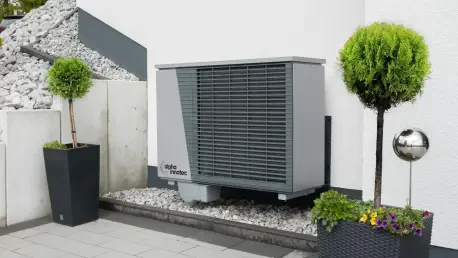What if the key to slashing energy bills and curbing environmental impact lies in a technology once thought to be pure science fiction? Quantum computing, with its mind-bending potential, is no longer confined to theoretical labs—it’s knocking on the door of everyday life, promising to transform something as mundane as home heating and cooling. Picture a world where HVAC systems, notorious for guzzling power, operate with such precision that costs plummet while comfort soars. This isn’t a distant dream but a rapidly approaching reality, driven by cutting-edge research that could redefine energy efficiency in homes across the globe.
The Hidden Cost of Comfort
HVAC systems, while essential for maintaining indoor comfort, are among the biggest energy consumers in residential spaces, often accounting for a significant slice of household expenses. Beyond the hit to wallets, their inefficiency fuels a larger problem—carbon emissions that exacerbate climate change. Traditional solutions, like occupancy-based controls, have offered some relief with energy savings ranging from 20 to 50%, yet they come with drawbacks such as lengthy payback times and privacy concerns tied to constant monitoring. As demands grow for both sustainability and better indoor air quality, the limitations of these older methods become glaringly apparent, signaling an urgent need for a smarter, more effective approach.
Quantum Computing: A Game-Changer for HVAC
Enter quantum computing, a field that harnesses the strange principles of quantum mechanics to process information at unprecedented speeds. Unlike classical computers, quantum systems can tackle complex, multi-dimensional problems—like optimizing HVAC performance across multiple zones in a home—with remarkable efficiency. This technology, through an approach called quantum reinforcement learning (QRL), promises to revolutionize how energy is managed in residential buildings by dynamically adjusting to variables such as temperature preferences, occupancy shifts, and even weather fluctuations. The potential here isn’t just incremental improvement; it’s a complete overhaul of what’s possible in energy management.
Unpacking the Science Behind QRL
At the core of this transformation is quantum reinforcement learning, a method that uses quantum algorithms to make real-time decisions far faster than traditional machine learning can. A pioneering study conducted by a team from Hanbat National University in South Korea tested QRL on data from 26 households over three months, revealing jaw-dropping results. Power consumption dropped by 63% and electricity costs by 64.4% compared to classical reinforcement learning models, all while maintaining thermal comfort for residents. This isn’t just about cutting bills—it’s about balancing cost, comfort, and carbon emissions through a single, adaptive controller that learns and responds to unpredictable conditions on the fly.
The significance of these findings lies in their real-world applicability. Unlike many experimental technologies, QRL is designed to integrate seamlessly with existing HVAC setups, requiring no major overhauls. This retrofit-friendly aspect means that homeowners and building managers could adopt this innovation without facing prohibitive costs or disruptions, making the leap to quantum-powered efficiency more accessible than ever before.
Voices from the Frontier of Innovation
The promise of QRL isn’t just theoretical—it’s backed by experts who see it as a cornerstone of future energy solutions. Assistant Professor Sangkeum Lee, who led the groundbreaking research, has described QRL as “a pathway to co-optimize comfort and sustainability without manual intervention.” His team’s simulations, detailed in a peer-reviewed journal, consistently outperformed established methods, showing a clear edge over classical approaches like deep deterministic policy gradient models. Dr. Lee also emphasized the technology’s scalability, noting that “its integration with current systems could accelerate adoption in homes and even small commercial spaces,” painting a future where quantum solutions become commonplace.
This optimism is grounded in hard evidence. The ability of QRL to handle uncertainty—whether from inaccurate weather forecasts or fluctuating occupancy—ensures reliability in diverse scenarios. Such robustness, combined with its potential to support grid-interactive programs like virtual power plants, positions QRL as not just a tool for individual homes but a building block for broader community-level sustainability efforts.
Bridging the Gap to Practical Adoption
While the concept of quantum computing may seem intimidating, steps toward integrating it into HVAC systems are already within reach for stakeholders. Keeping abreast of developments in QRL through industry publications and academic research can provide valuable insights into when commercial solutions might hit the market. Building managers and homeowners alike can start by assessing their current HVAC setups for compatibility with smart controls, as QRL systems are built to work with standard sensors and detectors already in use.
Collaboration is also key—partnering with tech innovators or local universities researching energy management can open doors to pilot programs or early access to QRL tools. On a larger scale, advocating for policies that support grid integration, such as demand-response initiatives, can amplify the impact of quantum-driven efficiency. These practical measures ensure that the transition from lab to living room isn’t just a possibility but a well-prepared reality waiting to unfold.
Reflecting on a Quantum Leap Forward
Looking back, the journey of quantum reinforcement learning from a niche concept to a tangible solution for HVAC efficiency stands as a testament to human ingenuity. The staggering reductions in power use and costs, paired with unwavering thermal comfort, mark a turning point in how residential energy is approached. Yet, the path ahead demands more than just admiration of past achievements—it calls for active engagement. Stakeholders are encouraged to explore retrofit opportunities, connect with innovators, and push for supportive policies starting in 2025 and beyond, ensuring that this technology scales from individual homes to entire communities. The challenge remains to test these systems in varied real-world conditions, addressing hurdles like cost and privacy, but the foundation laid by early research offers a robust starting point for a more sustainable tomorrow.









